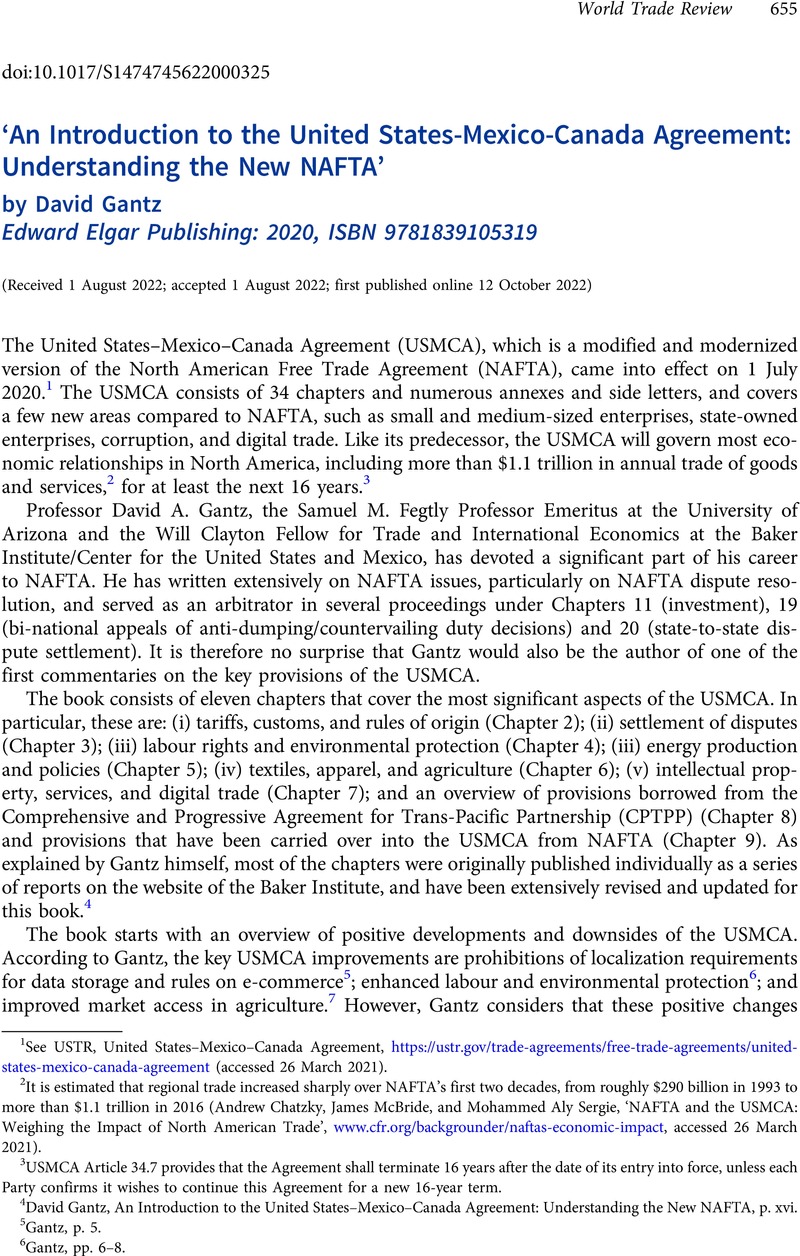Published online by Cambridge University Press: 12 October 2022

1 See USTR, United States–Mexico–Canada Agreement, https://ustr.gov/trade-agreements/free-trade-agreements/united-states-mexico-canada-agreement (accessed 26 March 2021).
2 It is estimated that regional trade increased sharply over NAFTA's first two decades, from roughly $290 billion in 1993 to more than $1.1 trillion in 2016 (Andrew Chatzky, James McBride, and Mohammed Aly Sergie, ‘NAFTA and the USMCA: Weighing the Impact of North American Trade’, www.cfr.org/backgrounder/naftas-economic-impact, accessed 26 March 2021).
3 USMCA Article 34.7 provides that the Agreement shall terminate 16 years after the date of its entry into force, unless each Party confirms it wishes to continue this Agreement for a new 16-year term.
4 David Gantz, An Introduction to the United States–Mexico–Canada Agreement: Understanding the New NAFTA, p. xvi.
5 Gantz, p. 5.
6 Gantz, pp. 6–8.
7 Gantz, pp. 9–10.
8 As Gantz explains, except for R&D and engineering, only Canadian and American facilities would meet this requirement since typical auto industry wages in Mexico are $3.60–$3.90/hour (Gantz, p. 11).
9 Gantz, pp. 14–19.
10 Gantz, pp. 80 and 93.
11 Gantz, p. 82.
12 USMCA, Annex 31-A (United States and Mexico), Annex 31-B (Canada and Mexico).
13 USMCA, Articles 31-A.4.2 and 31-A.4.4.
14 United States Seeks Mexico's Review of Alleged Worker's Rights Denial at Auto Manufacturing Facility, 12 May 2021, https://ustr.gov/about-us/policy-offices/press-office/press-releases/2021/may/united-states-seeks-mexicos-review-alleged-workers-rights-denial-auto-manufacturing-facility-0 (accessed 1 September 2021).
15 United States Seeks Mexico's Review of Alleged Freedom of Association Violations at Mexican Automotive Parts Factory, 9 June 2021, https://ustr.gov/about-us/policy-offices/press-office/press-releases/2021/june/united-states-seeks-mexicos-review-alleged-freedom-association-violations-mexican-automotive-parts (accessed 1 September 2021).
16 In the first case, the remediation agreement between the United States and Mexico called for a new union vote to be held. As a result of the new vote, workers chose to reject their existing collective bargaining agreement. (United States and Mexico Announce Course of Remediation for Workers' Rights Denial at Auto Manufacturing Facility in Silao, 8 July 2021, https://ustr.gov/about-us/policy-offices/press-office/press-releases/2021/july/united-states-and-mexico-announce-course-remediation-workers-rights-denial-auto-manufacturing, accessed 1 September 2021). In the second case, the US Trade Representative reached an agreement with the company at issue, as part of which the company undertook to provide severance and backpay to workers, as well as to ensure labour rights (United States Reaches Agreement with Mexican Auto Parts Company to Protect Workers' Rights, 10 August 2021, https://ustr.gov/about-us/policy-offices/press-office/press-releases/2021/august/united-states-reaches-agreement-mexican-auto-parts-company-protect-workers-rights, accessed 1 September 2021).
17 Inu Manak, Statement for the Record, Hearing on ‘Implementation and Enforcement of the United States–Mexico–Canada Agreement: One Year After Entry into Force’, www.cato.org/testimony/hearing-implementation-enforcement-united-states-mexico-canada-agreement-one-year-after (accessed 1 September 2021).
18 Gantz, pp. 48–49.
19 USMCA, Article 31.8.1.
20 Gantz, p 66.
21 Gantz, p. 65.
22 In May 2021, the United States requested the establishment of a panel to examine Canada's allocation of tariff-rate quotas on dairy products. (United States Advances First USMCA Dispute Panel to Enforce Canada's Dairy Commitments, 25 May 2021, https://ustr.gov/about-us/policy-offices/press-office/press-releases/2021/may/united-states-advances-first-usmca-dispute-panel-enforce-canadas-dairy-commitments, accessed 1 September 2021). Furthermore, in June 2021, Canada requested that a panel be established to examine the United States’ safeguard measures on crystalline silicon photovoltaic cells. (Request for the establishment of a panel by Canada – Solar Products, 17 June 2021, www.international.gc.ca/trade-commerce/trade-agreements-accords-commerciaux/agr-acc/cusma-aceum/solar-products-produits-energie-solaire.aspx?lang=eng, accessed 3 September 2021).
23 USMCA, Article 31.9.1.
24 See USMCA Secretariat, Publications, https://can-mex-usa-sec.org/secretariat/report-rapport-reporte.aspx?lang=eng (accessed 1 September 2021).
25 Gantz, pp. 145–148.
26 Gantz, p. 167.
27 The ‘yarn forward rule’ means that the yarn used to form the fabric used to produce wearing apparel or other textile articles must originate in a NAFTA country (see US Customs and Border Protection, Textile and Apparel Products, www.cbp.gov/trade/nafta/guide-customs-procedures/provisions-specific-sectors/textiles, accessed 1 September 2021).
28 Gantz, pp. 124–125.
29 Gantz, pp. 129–132.
30 Gantz, pp. 101–121.
31 Gantz, pp. 231–233.
32 Gantz, pp. 233–235.